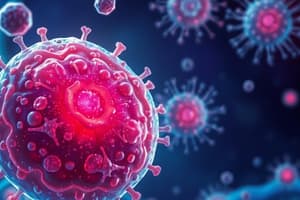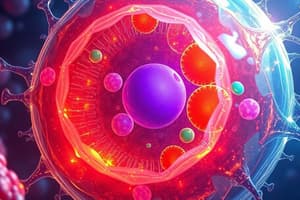Podcast
Questions and Answers
Which cellular component is primarily responsible for ATP synthesis?
Which cellular component is primarily responsible for ATP synthesis?
- Mitochondria (correct)
- Chloroplasts
- Endoplasmic Reticulum
- Nucleus
What is a primary difference between a prokaryotic and a eukaryotic cell?
What is a primary difference between a prokaryotic and a eukaryotic cell?
- Prokaryotic cells perform photosynthesis.
- Prokaryotic cells have membrane-bound organelles.
- Eukaryotic cells are generally smaller.
- Eukaryotic cells have a nucleus, while Prokaryotes do not. (correct)
What is the fundamental role of the nucleoid in a prokaryotic cell?
What is the fundamental role of the nucleoid in a prokaryotic cell?
- Producing ATP
- Synthesizing proteins
- Containing the cell's genetic material (correct)
- Digesting cellular waste
In a eukaryotic plant cell, which organelle contains the light-capturing pigment chlorophyll?
In a eukaryotic plant cell, which organelle contains the light-capturing pigment chlorophyll?
Which type of endoplasmic reticulum is directly associated with protein synthesis?
Which type of endoplasmic reticulum is directly associated with protein synthesis?
What is the primary role of the smooth endoplasmic reticulum?
What is the primary role of the smooth endoplasmic reticulum?
Which of the following describes the size range of a typical eukaryotic cell?
Which of the following describes the size range of a typical eukaryotic cell?
What is the main function of the nucleus within a eukaryotic cell?
What is the main function of the nucleus within a eukaryotic cell?
Which kingdom includes organisms characterized as unicellular prokaryotes?
Which kingdom includes organisms characterized as unicellular prokaryotes?
What is the primary role of decomposers in an ecosystem?
What is the primary role of decomposers in an ecosystem?
Which of the following structures is responsible for producing sperm in the male reproductive system?
Which of the following structures is responsible for producing sperm in the male reproductive system?
In plant sexual reproduction, what is the process of transferring pollen from the anther to the stigma called?
In plant sexual reproduction, what is the process of transferring pollen from the anther to the stigma called?
Which organelle is primarily responsible for modifying and packaging proteins?
Which organelle is primarily responsible for modifying and packaging proteins?
What is the type of cell division that results in two genetically identical diploid cells?
What is the type of cell division that results in two genetically identical diploid cells?
What is the primary function of the small intestine?
What is the primary function of the small intestine?
Which of these organisms is an example of a multicellular, heterotrophic organism?
Which of these organisms is an example of a multicellular, heterotrophic organism?
Which of the following terms best describes plants that convert sunlight into energy?
Which of the following terms best describes plants that convert sunlight into energy?
Which of the following best describes the function of the circulatory system?
Which of the following best describes the function of the circulatory system?
What is the role of the trachea in the respiratory system?
What is the role of the trachea in the respiratory system?
In Mendelian genetics, what term describes a version of a gene?
In Mendelian genetics, what term describes a version of a gene?
Which component of the blood is essential for carrying oxygen?
Which component of the blood is essential for carrying oxygen?
What is the function of the hydrolytic enzymes found in lysosomes?
What is the function of the hydrolytic enzymes found in lysosomes?
Which of the following represents the correct order of taxonomic hierarchy (from broadest to most specific)?
Which of the following represents the correct order of taxonomic hierarchy (from broadest to most specific)?
Which of the following is NOT a key organ of the digestive system?
Which of the following is NOT a key organ of the digestive system?
Which process directly contributes to genetic variation in the four haploid gametes produced during meiosis?
Which process directly contributes to genetic variation in the four haploid gametes produced during meiosis?
What is the primary role of the light-dependent reactions in photosynthesis?
What is the primary role of the light-dependent reactions in photosynthesis?
In cellular respiration, where does the majority of ATP production occur?
In cellular respiration, where does the majority of ATP production occur?
According to Darwin's theory of evolution, which factor primarily drives natural selection?
According to Darwin's theory of evolution, which factor primarily drives natural selection?
Which of the following is a structural adaptation?
Which of the following is a structural adaptation?
What is the function of CRISPR-Cas9 in genetic engineering?
What is the function of CRISPR-Cas9 in genetic engineering?
What is PCR (Polymerase Chain Reaction) primarily used for in biotechnology?
What is PCR (Polymerase Chain Reaction) primarily used for in biotechnology?
What is the primary purpose of Gel Electrophoresis?
What is the primary purpose of Gel Electrophoresis?
Flashcards
Cells
Cells
The fundamental building blocks of all living organisms, responsible for carrying out life processes.
Prokaryotic cells
Prokaryotic cells
Simple and small, lacking a nucleus and other internal compartments. These cells make up bacteria and archaea.
Eukaryotic cells
Eukaryotic cells
More complex cells with a defined nucleus and internal organelles, found in plants, animals, fungi, and protists.
Nucleus
Nucleus
Signup and view all the flashcards
Mitochondria
Mitochondria
Signup and view all the flashcards
Chloroplasts
Chloroplasts
Signup and view all the flashcards
Endoplasmic Reticulum (ER)
Endoplasmic Reticulum (ER)
Signup and view all the flashcards
Cellular respiration
Cellular respiration
Signup and view all the flashcards
Five Kingdoms
Five Kingdoms
Signup and view all the flashcards
Monera
Monera
Signup and view all the flashcards
Protista
Protista
Signup and view all the flashcards
Fungi
Fungi
Signup and view all the flashcards
Plantae
Plantae
Signup and view all the flashcards
Animalia
Animalia
Signup and view all the flashcards
Ecosystem
Ecosystem
Signup and view all the flashcards
Reproduction
Reproduction
Signup and view all the flashcards
Photosynthesis
Photosynthesis
Signup and view all the flashcards
Digestive System
Digestive System
Signup and view all the flashcards
Respiratory System
Respiratory System
Signup and view all the flashcards
Circulatory System
Circulatory System
Signup and view all the flashcards
Nervous System
Nervous System
Signup and view all the flashcards
Taxonomic Hierarchy
Taxonomic Hierarchy
Signup and view all the flashcards
Ecology
Ecology
Signup and view all the flashcards
Mitosis
Mitosis
Signup and view all the flashcards
Meiosis
Meiosis
Signup and view all the flashcards
Natural Selection
Natural Selection
Signup and view all the flashcards
Structural Adaptations
Structural Adaptations
Signup and view all the flashcards
Behavioral Adaptations
Behavioral Adaptations
Signup and view all the flashcards
CRISPR-Cas9
CRISPR-Cas9
Signup and view all the flashcards
Study Notes
Cell Structure and Function
- Cells are the basic units of life, categorized as prokaryotic or eukaryotic.
- Prokaryotic cells lack a nucleus and membrane-bound organelles, with genetic material in the nucleoid. They are smaller (1-10 micrometers). Examples include bacteria (Escherichia coli, Streptococcus) and archaea (Methanogens, extremophiles).
- Eukaryotic cells have a defined nucleus and membrane-bound organelles. They are larger (10-100 micrometers). Examples include plant cells (Elodea, onion cells) and animal cells (human epithelial cells).
Organelles and Functions
- Nucleus: Contains DNA organized into chromatin, controlling cellular activities.
- Mitochondria: The "powerhouse" of the cell, responsible for aerobic respiration and ATP synthesis.
- Chloroplasts: Found in plant cells, site of photosynthesis, capturing sunlight for energy conversion.
- Endoplasmic Reticulum (ER): Smooth ER synthesizes lipids and detoxifies substances; Rough ER, studded with ribosomes, synthesizes proteins.
- Ribosomes: Synthesize proteins, either free in the cytoplasm or attached to the ER.
- Golgi Apparatus: Modifies, sorts, and packages proteins and lipids for transport.
- Lysosomes: Contain enzymes to digest cellular debris.
- Cytoskeleton: Provides structural support and facilitates cellular movement.
Human Organ Systems
- The human body is a complex system of interconnected organs and tissues.
- Digestive System: Converts food to nutrients and energy, with organs like the mouth, stomach, small intestine, liver and pancreas.
- Respiratory System: Facilitates gas exchange (oxygen intake and carbon dioxide removal). Organs include nose, nasal cavity, trachea and lungs.
- Circulatory System: Transports nutrients, oxygen, hormones, and waste products. Components include the heart, blood vessels, and blood.
- Nervous System: Controls body activities via electrical signals. Includes the brain, spinal cord, and nerves.
Classification of Living Things
- Classification organizes biodiversity into hierarchical categories (Kingdom, Phylum, Class, Order, Family, Genus, Species).
- The five kingdoms are Monera (prokaryotes), Protista (simple eukaryotes), Fungi (decomposers), Plantae (photosynthetic), and Animalia (heterotrophs).
Ecosystems
- Ecosystems are dynamic systems where organisms interact with their environment.
- Components include biotic (living organisms, like plants, animals, fungi and microbes) and abiotic factors (non-living parts, such as sunlight, water, air, and soil).
- Energy flows through ecosystems (producers → consumers → decomposers).
Reproductive Systems
- Reproduction ensures the survival of species.
- Human Reproductive System includes male (testes, seminal vesicles and prostate) and female (ovaries, uterus) components.
- Plant Reproduction: Can be sexual (pollen transfer, fertilization) or asexual (budding, vegetative propagation, fragmentation).
Genetics
- Genetics studies genes, heredity, and genetic variation.
- Key figures include Gregor Mendel, whose experiments established inheritance laws.
- Genetic disorders encompass conditions caused by genetic variation (e.g., Sickle cell anemia, cystic fibrosis).
Cell Division
- Cell division is crucial for growth, repair, and reproduction.
- Mitosis produces two genetically identical diploid cells. Phases include Prophase, Metaphase, Anaphase, Telophase, Cytokinesis.
- Meiosis creates four haploid gametes with genetic variation, involving two consecutive divisions.
Photosynthesis and Cellular Respiration
- Photosynthesis converts light energy into chemical energy (glucose), using the equation 6CO2 + 6H2O + Light → C6H12O6 + 6O2. This process occurs in stages (Light-dependent and Calvin Cycle).
- Cellular Respiration breaks down glucose to release ATP (energy). Types include aerobic (requiring oxygen) and anaerobic (without oxygen). Stages involve Glycolysis, Krebs Cycle, and Electron Transport Chain.
Evolution and Adaptation
- Natural selection favors traits that enhance survival and reproduction.
- Adaptations can be structural (physical features) or behavioral.
Biotechnology
- Biotechnology applies biological processes for practical uses, often relating to genetic engineering and cloning
- Genetic Engineering uses techniques like CRISPR-Cas9 for precise DNA editing. Examples include medical treatments (insulin production) agricultural applications (modified crops), and environmental applications (bioremediation).
- Cloning replicates organisms through various methods. Example include Dolly the sheep.
- Biotechnological tools like PCR and gel electrophoresis are used to analyze and manipulate DNA.
Studying That Suits You
Use AI to generate personalized quizzes and flashcards to suit your learning preferences.




